Things on my mind as I prepare for the business/economy segment on KUOW‘s Weekday program at about 10:40 a.m. Pacific time May 29: 1. The Boeing Boom? So over. The headlines over the past several weeks about layoffs and other cutbacks at Boeing (excellent coverage in the Seattle Times by [continue reading . . . ]
Years ago, from a back-row press seat at a Microsoft financial analyst meeting, I heard CEO Steve Balmer bellow that Microsoft would make software that “just works.” If memory serves, the much unloved Windows Vista was then the flavor of the month. In time it was succeeded by Windows 7, [continue reading . . . ]
For those of a certain age, the billboard remains etched in memory. It was April 1971. Boeing employment over the course of about three years had collapsed from more than 100,000 to fewer than 40,000 following cancellation of government funding for a supersonic transport and commercial orders for the then-shiny-new [continue reading . . . ]
The late Lady Margaret Thatcher had a four-word response to those who questioned her commitment to free and competitive markets: “There is no alternative.” The response earned her, so the Wall Street Journal reports, the nickname TINA, an obvious acronym. It occurs to me that the phrase is an appropriate [continue reading . . . ]
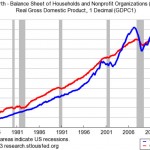
A correspondent who heard me last week on KUOW‘s Weekday program asks if there is research on “a correlation between the wealth lost in a downturn and the length of following recovery.” I told him the book to read is This Time Is Different: Eight Centuries of Financial Folly By Carmen [continue reading . . . ]
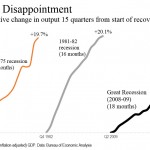
How anemic has been the recovery from the Great Recession? Here’s one way of looking at it. Until the Great Recession (December 2007-June 2009), the lengthiest recessions of the post-World War II era were 1973-1975 and 1981-1982, both at 16 months. The Business Cycle Dating Committee of the National Bureau [continue reading . . . ]
A correspondent who heard my comments on Cyprus on KUOW’s Weekday program today asks: I am puzzled by some of your comments this morning. As I understand it, when a bank in the U.S. fails, the FDIC moves in and closes it. The accounts are protected by insurance up to [continue reading . . . ]
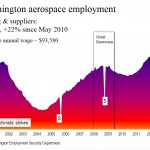
Aerospace employment in Washington has grown by an average of 520 a month in the 34 months since the cyclical low in late spring 2010 (top chart). Is another bust in the offing? The volcano has begun to rumble. The Seattle Times reported March 22 that Boeing will lay off [continue reading . . . ]
Marple’s Letter, which analyzed the Pacific Northwest economy for generations of business leaders, has succumbed. The final issue was dated March 6. The newsletter’s passing, a few weeks shy of its 64th anniversary, was due to declining circulation. Editor Jim Murez and Publisher Jon Anderson wrote that despite their best [continue reading . . . ]
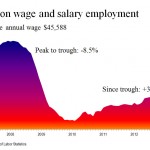
I was asked to say a few words about Oregon’s economy at the PEMCO management forum that I addressed on President’s Day. In preparation, I worked up a few Oregon charts comparable to those I use for Washington’s economy. The contrasts are dramatic. The Great Recession and its aftermath cost [continue reading . . . ]

Amazon.com and Boeing dominated the business headlines in the Seattle area in 2012. Looks like we are in for more of the same in 2013. Eric Pryne of the Seattle Times, the go-to guy for news about Amazon’s gargantuan appetite for office space in the Seattle area, reported last week [continue reading . . . ]
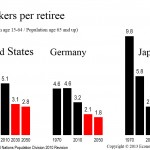
Do Malthusian nightmares about the population explosion keep you up nights? Relax. Chill. We Americans (numbering 315 million) are having too few babies. Middle-class fertility has fallen to about 1.6, far below the replacement rate of 2.1. That means fewer workers to support your Social Security benefits. And the problem [continue reading . . . ]